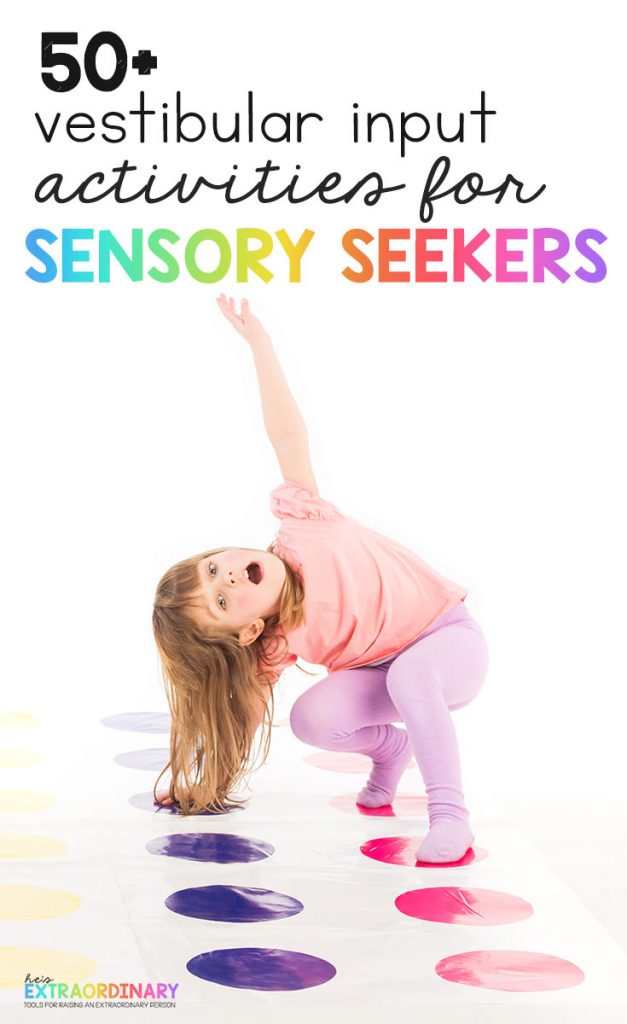52 Vestibular Input Activities For Sensory Seekers
What’s inside this article: A brief overview of the vestibular system and how these activities can benefit kids, then 52 vestibular input activities to try.
When it comes to sensory activities, vestibular input activities are probably my favorite. When I first started learning about how sensory activities could help kids, I hadn’t even heard of the vestibular system.
But, it turns out vestibular input activities are the most effective for keeping my sensory seeker calm.
What is the Vestibular System?
The vestibular system is your sense of movement.
It’s located in the inner ear. The vestibular system transmits sensory information to the brain based on your head’s position in relation to your body.
It plays a role in:
- Balance
- Motor planning
- Motor skills
- Coordination
- Posture
- Body awareness
- Spatial awareness
You can learn how the vestibular system works in detail here.
Benefits of Vestibular Input Activities
Often, warning signs that something is off with the vestibular system are mistaken for behavioral issues, similar to the proprioceptive system.
It may lead to academic problems, issues with muscle development, and issues with attention.
Also, it may be the reason why a child is stimming, or just fidgeting and acting hyperactive, because they feel a need to move to stimulate this system.
If your child is a sensory seeker, a dose of vestibular input can literally keep them calm for hours. It can help them stay seated and focused at school when it’s most necessary.
Providing your child with enough vestibular input may also reduce meltdowns and aggressive behaviors.
There is also research suggesting that providing vestibular input during stages of critical development (like childhood) can improve cognitive functions long-term.
Word of Caution
Even though many children benefit from extra vestibular input, some children have vestibular defensiveness, and too much movement causes them anxiety or nausea.
You should always respect your child’s sensory preferences.
If they ask you to stop an activity, stop right away. Forcing your child to participate in activities that cause them over stimulation can cause meltdowns and behavioral issues that last for hours.
Vestibular Input Activities
Okay, so on to the activities.
Note that the vestibular system and the proprioceptive system work together closely, so many of these vestibular input activities also double as proprioceptive input activities.
By the way, hanging upside down is one of the most potent forms of vestibular input because it provides such a unique sensory experience.
- Hanging upside down from the couch
- Children’s yoga
- Swinging from and hanging upside down from the monkey bars
- Sit your child on your lap facing you and hold their hands while you let them drop back upside down over your knees, and then pull them back up.
- Leaning backward over an exercise ball
- Gymnastics activities – somersaults, rolls, balance beam, cartwheels, etc.
- A door-mounted trapeze bar
- Freeze dance
- Riding a bike
- Kids 7-minute HIIT
- Playground activities – swinging, sliding, monkey bars
- Swimming
- Jumping on a trampoline
- Bouncing on your lap
- Pulling them around the floor on a blanket
- Piggyback rides
- Ring around the Rosie
- Spinning them in an office chair
- Any amusement park ride
- Roll down a big grassy hill
- Get your child to lay on their belly on a swing. Then, twist it up and let go so they spin while it unwinds.
- The Dizzy Disk
- Simon Says – use commands like Simon Says tilt your head, Simon says do a somersault, etc.
- Scooter board rides
- Jump rope
- Get them a rocking chair
Keep scrolling for more ideas

- Play tag
- Red Rover
- Use an indoor sensory swing – see 10 indoor swings for under $100
- Hopscotch
- Rocking horse
- Make an indoor obstacle course – use furniture, make lines with some tape they must walk on, or tape across doorways to crawl under, etc.
- For school or appointments, try bringing along an inflatable wobble disk for their seat
- Get them to imitate your head movements – tilt your head left, right, up, down, etc. Since the vestibular system’s organs are located within the inner ear, changing your head position provides vestibular input.
- Leapfrog
- Jump and fall into a crash mat.
- Wooden Wobble Board
- Have a dance party
- Swaying in a hammock

- Take them rock climbing or build your own climbing wall (read the tutorial for a DIY climbing wall)
- Hold your child in your arms (like a baby) and rock them back and forth
- Ballet
- Play Twister
- Do the hokey-pokey!
- In the winter – sledding or using a crazy carpet
- In the summer – water slides, or a slip and slide for the back yard
- Organized sports and activities – if your child is uncomfortable with sports and struggles with social skills you can also try 1:1 training for martial arts
- Give your child an “airplane ride”: Lay on your back and. while holding your child’s hands, lift them in the air with your knees or feet, and rock them back and forth.
- Handstands – you can hold your child up since I know most people can’t do this independently.
- Follow the leader
- Blow bubbles and get your kids to run around and try to pop them
- Musical chairs

